Pepper variety Bhut Jolokia
Bhut Jolokia, or ghost pepper, is classified as an extremely spicy variety. Moreover, at one time this natural hybrid was considered the hottest pepper on our planet. But the world is changing rapidly, and Jolockia in this nomination was first ousted by Trinidad Moruga Scorpio, and then by the Carolina reaper, whose sharpness is comparable only to chemical weapons.
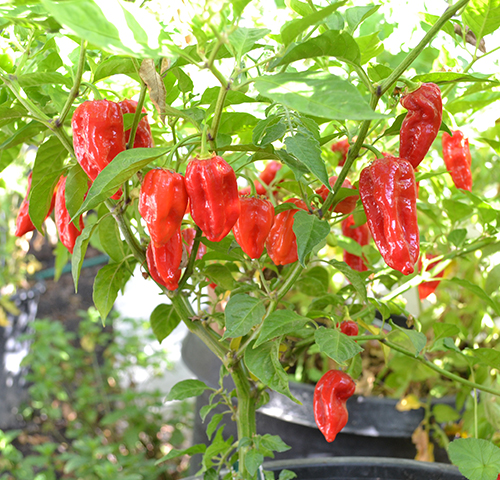
In this regard, our pepper has somewhat lost its popularity, although its cultivation used to be associated with a number of difficulties.
Plant characteristics
Plants reach a height of 150 cm. Fruits are wrinkled, extremely diverse in appearance. Ripe pods have a very thin skin that breaks easily. Fruit length 6 - 9 cm. The color is red, yellow, orange, chocolate or purple (rare). The aroma is a mixture of tropical fruits. Seeds are wrinkled, remain viable for 3-4 years.
Features of cultivation
In general, growing extremely hot peppers holds back two misconceptions:
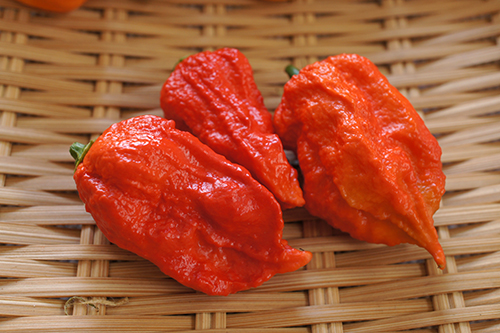
- First: supposedly pepper of any, especially exotic varieties, does not tolerate transplanting well.
- Second: pepper is an annual culture.
The thing is that extremely spicy varieties have a long growing season (for Bhut Jolokia it is close to 200 days), and in our climate they simply do not have time to bring a sufficient harvest.
There are, again, exactly two ways out in such a situation. Either plant seeds for seedlings in December - January, or proceed to perennial cultivation of pepper.
The first method does not bring the desired result, since even in an apartment the winter sun will not transfer the necessary energy to the plants, and the use of phyto-lamps can cost a pretty penny.
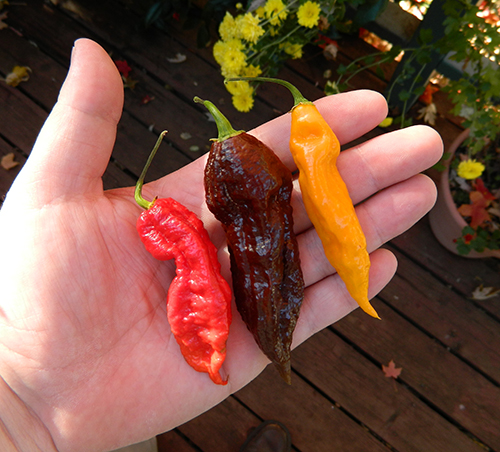
Let's dwell on the second method and consider it using the example of Bhut Jolokia. Why do we recommend this particular variety for technology development? Jolocia is not as capricious as Moruga, her seeds have a traditionally high similarity. There are some unpleasant moments, but we will talk about them below and later.
Growing Bhut Jolokia in a perennial culture
We recommend starting germination of pepper seeds in early February. Then by May you will have a fully formed plant.
Even during the flowering period, any pepper can be transplanted by transshipment. In other words, it is necessary to keep a sufficient clod of earth on the roots. But what pepper really doesn't like is a sharp change in climate. And moving from the garden to the house for a plant is no less dangerous than taking it from the premises to the street. This process rarely leads to the death of the plant, but it pretty much inhibits its development. Therefore, we recommend acclimatization before planting Bhut Jolokia in the ground. First, take it out of the house during daylight hours, then place it on the beds for several nights without planting it, and only after that, transplant it into the ground.
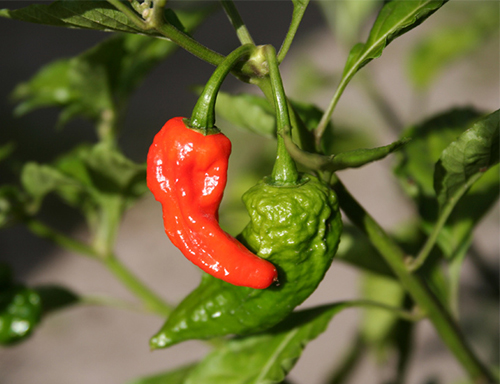
Growing pepper in the ground does not involve any particular difficulties. Our chosen one is a native of India, the state of Assam. Consequently, heat is normal weather for him. Abundant sun is a must. In black soil and versatile flower substrates, Jolokia grows well. But you can pamper your pet with potash fertilizers. The bush is high - up to one and a half meters, and, as a rule, the stem needs props and garters. The yield for hot peppers is high - up to 4 kg per square meter.
Since this crop is massive, it easily stores moisture in the leaves and trunk, and is less susceptible to drought than the compact Habanero. But we also do not recommend overdrying the pepper - in a dry climate, its severity is almost halved.
For watering, we advise you to dig upturned plastic bottles with a cut-off bottom between the bushes and pour water into them. Then the moisture will be delivered directly to the roots, which will reduce the cost of irrigation.
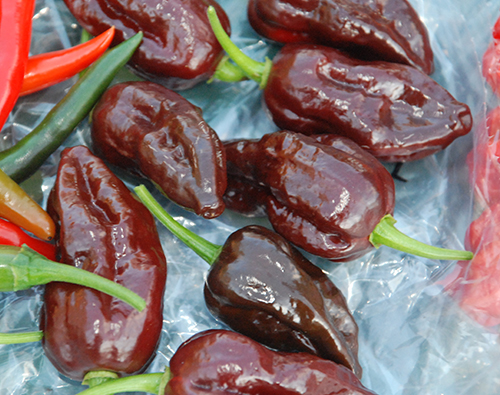
But autumn is coming, and the harvest has not yet ripened or does not please you with the amount. What to do? And we move on to exposing the second misconception.
Any pepper is a perennial culture. It is unprofitable to tinker with plants just with ordinary varieties and with mass planting. The situation is quite different with the exotic.On the windowsill, some Tabasco or Cayenne can bear fruit for several years. Accordingly, any variety of pepper can be grown at home. The only question is pot size and space.
So, we repeat the procedure for planting seedlings exactly the opposite, giving time for the acclimatization of the plant.
Cons of a hybrid
And what is unpleasant about growing Bhut Jolokia? Disadvantages stem from merits. The variety is not very suitable for growing in unsuitable premises. A 5 liter pot is too small for a plant, its root system seeps through the drainage holes onto the pallet. The pepper grows to the full height of the window.
The winter harvest of Bhut Jolokia is limited, but the plant blooms and knits even in December. But the fruits, although they have the usual sharpness, usually (but not always) grow tiny - the lack of lighting affects.
If, in an apartment, aphids simply do not survive on Moruga or the Caroline Reaper, then on Bhut Jolokia it is quite possible.
Conclusion
The second name of Bhut Jolokia is Naga Jolokia, in honor of the cruel and skillful warriors of Nagaland. And, by the way, this pepper fights pretty well - a mixture is made from it for gas cartridges and grenades, the irritating substance of the subject of our conversation is used to poison bandits from underground cities and caves.
Well, we love it as a spice. The variety is great for savory sauces, and the whole Jolockia fruit is spicy, and not just the amniotic pulp, as in other varieties. We remind you that pepper sauces go well with meat, and excess pungency in the mouth can be removed with alcohol or milk. And at parties for drawing guests, Bhut Jolokia is completely irreplaceable.
Help yourself. It will be hot!
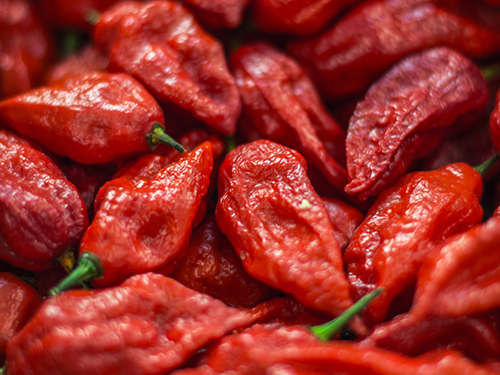
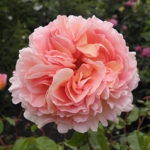
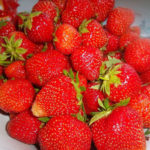
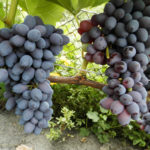
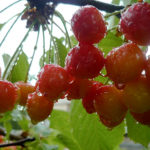
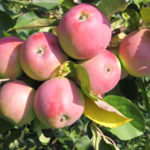
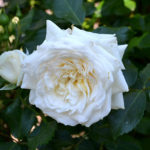



I grow red Bhut Jolokia on a permanent basis. In fact, it is easy to grow it, the main thing is to soak the pepper seeds at the end of February and plant them at the same time. Only then will you get red fruits in August - September. The fruits usually ripen up to 30 pieces and the most interesting thing is that the pepper is constantly blooming - some fruits ripen, others are just tied. In size - 6 - 7 cm in length, they can be pimply, which immediately leads to the conclusion about their dangerous severity. There are 20 seeds in pepper. The peel of the fruit is not very thick, with a peculiar smell of citrus, with hints of valerian. To taste - it's like a hot coal burns your tongue, the sharpness is felt for a long time. Large fruits are tied when there is a lot of sun for the plant; in other cases, you get a trifle without seeds. It can be easily grown on a windowsill or balcony, but it needs a lot of sun. It is advisable to pollinate yourself with a brush.
Also in recent years, I got hooked on growing hot peppers. I don't have my own summer cottage, and I grow it on the windowsill. I did not notice any particular difficulties in growing. In the collection there is Bhut Jolokia (orange) - this is generally a terrible pepper, it is better to take it with gloves. The severity of 1 million according to Scoville, but I think I have much less - under 500 thousand (little sun). In shape, it is a pimpled fruit with a sharp tip, the size of a plum; up to 30 orange fruits grow on the plant. Usually I grow in a 10 liter flowerpot. The plant is large and spreading, loves light very much. Looks very nice with ripe fruits.
And I was afraid that my brown Jolocia seeds would not sprout. I read about the poor germination of such peppers, but no, out of 10 planted seeds, 8 germinated, and this is a good indicator. I planted some of the plants in a greenhouse and a few on the windowsill.What can I say, on the windowsill the fruits ripened 2 weeks earlier than in the greenhouse. There were about 30 fruits. The smell is pleasant, but the taste is something, I must say right away, not for beginners. Even though I am a fan of the spicy, Jolockia is spicy even for me. The plant is beautiful, especially when the fruits are ripe, the whole bush is strewn with chocolate fruits, it looks cool. What I understood: anyone can grow such peppers, it's not difficult.